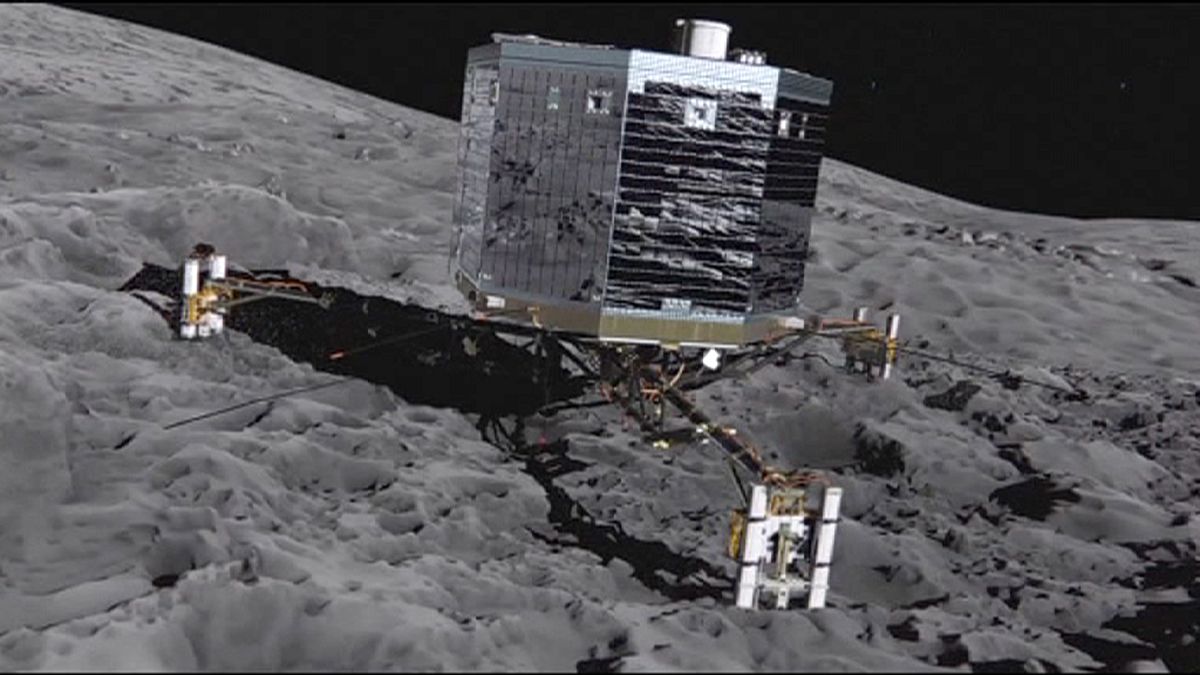Scientists at the European Space Agency are hoping to make up for lost time, gathering data from a re-awoken robotic space probe. The Philae lander
Scientists at the European Space Agency are hoping to make up for lost time, gathering data from a re-awoken robotic space probe.
The Philae lander went into emergency hibernation seven months ago after a botched landing on a comet.
It had been released from its mothership Rosetta in November after a 6.4 billion km journey that took more than 10 years – a mission that cost close to 1.4 billion euros.
Back then the initial joy of the landing was quickly replaced by despondency as no one knew if it would ever start up again.
Incredible news! My lander Philae is awake! http://t.co/VtzAQHx4zTpic.twitter.com/SZqnsnNpUZ
— ESA Rosetta Mission (@ESA_Rosetta) June 14, 2015
Matt Taylor who is a Rosetta project scientist clearly relishes the prospect of getting his hands on some of Philae’s precious data.
“We are going to look and try to repeat some of the operations we did in November, it completed its first science sequence in November, when we first landed. Then it was designed to go into hibernation and it has been in hibernation all this time. We are going to target some of the things we missed out, we drilled, but we need to drill again to get some of the surface material, to get some of that prime science. So it’s now going to go into what we call the long-term science and that’s what we have been waiting for. It’s all good news.”
It is thought that increased sunlight as the comet speeds closer to the sun gave Philae’s solar panels an energy boost enabling it to recharge its batteries.
Philae’s official Twitter account also came back to life:
Hello
ESA_Rosetta</a>! I'm awake! How long have I been asleep? <a href="https://twitter.com/hashtag/Lifeonacomet?src=hash">#Lifeonacomet</a></p>— Philae Lander (Philae2014) June 14, 2015
Now scientists have renewed hope that Philae’s transmitted data will eventually unlock details about how the planets – and possibly even life – evolved.
Analysis: Philae is awake! What now for the fairytale Rosetta mission?
The news that Philae is awake and sending messages to its Rosetta mothership is the biggest news in space exploration this year, writes Jeremy Wilks, Euronews’ space expert. The world has been waiting for seven months for news from the little lander, which famously bounced down onto comet 67P/Churyumov–Gerasimenko last November. Now this story has become a fairytale. The Sleeping Beauty of space has stirred from its slumber.
The call from Philae came on Saturday night, and was confirmed by the European Space Agency (ESA) on Sunday. Now the question is: ‘What next?’
There’s an answer. The Rosetta and Philae teams, spread all over Europe, have not been caught out by this breaking news.
In fact they have spent a fair amount of time planning exactly what kinds of science operations Philae could do if it came back to life, and will have a clear list of tasks for it, ranked according to scientific importance and their expected demand on the probe’s energy levels.
Those tasks could begin with low power jobs such as taking photos and temperature readings. Then, if Philae is performing well, they could move on to more complicated tasks, such as using the famous drill to dig into the comet surface and take a sample.
The drill didn’t reach the surface in November because Philae landed awkwardly, sprawled across a cliff. But the lander’s body can rotate on its legs, so it could get another chance to poke its instruments into the primordial cometary material below.
There are also some members of the science team who have suggested trying to make Philae hop, but it’s a high-risk manoeuvre that nobody will be contemplating for many months to come, if ever.
The great news is that it appears that Philae has been awake and calling for its mummy for some time, perhaps a few days. The information from the lander passed to Earth through Rosetta will give vital information about how much light it is receiving, which impacts how much power it has.
The data from the German Space Agency (DLR) in Cologne, where Philae is controlled, is that the robot explorer has an operating temperature of minus 35 degrees Celsius and 24 watts of power. Sounds cold to you and me, but it’s pretty good for Philae.
Those figures could improve over the coming weeks, too, as Philae is hurtling towards the inner solar system on board the comet. Its closest approach to the Sun is due in August, when the comet will be around about the same distance from our star as the planet Mars.
Why is all this interesting and useful? It’s interesting because the Rosetta mission is arguably the most ambitious mission ever flown by ESA and it partners CNES, DLR, ASI, NASA and MPS, and it shows how far mankind can go in exploring the solar system if the greatest minds in spacecraft control and navigation, science instrument design and robotics are brought together to work as a team.
It’s useful because the science is extremely important: comets are made from the oldest material in our solar system, so if we can work out what they’re made from, we might find out where we came from. It’s as simple and profound as that.
Meanwhile the larger Rosetta mission has been in full swing all the while we’ve been waiting for Philae, gathering surprising new data about the comet, and observing how it changes as it approaches the Sun, jets of gas and dust spraying out from below the surface.
The mission has taught us a lot already, and sent many experts back to the drawing board, in particular the finding that the water on this comet does not match the water on Earth (as had been expected) and the comet does not have a magnetic field, something that leaves planetary formation theorists scratching their heads.
Many, even in the Rosetta team, thought the Philae adventure was over. It’s not, and there are likely many more surprises to come from this groundbreaking space mission.


